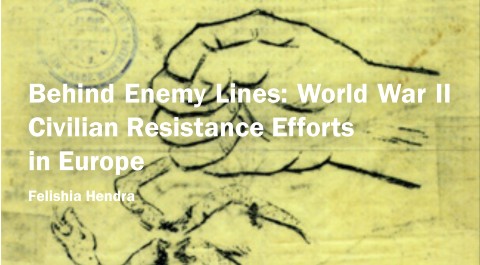Table of Contents
AYAHUASCA CULTURE OR DRUG?
Pamela Flores
Tutor Burnout: How it is Caused and How to Combat it
Gracie Ferguson
Healing Waters
Darian Fox
A New Wave of the Prescription Stimulant Epidemic
Sabrina Bustos
Rebranding Tween Girls' Media and Tech Camp
Chloe McElmury
Behind Enemy Lines: World War II Civilian Resistance Efforts
Felishia Hendra
AYAHUASCA CULTURE OR DRUG?
Pamela Flores
Syracuse University
The essay addresses the controversy of Ayahuasca, a cultural ritual performed in the Peruvian Amazon. In this creative text, the author tells her own experience trying Ayahuasca and explores the two sides of the argument of Ayahuasca being "culture" or a "drug."
Tutor Burnout: How it is Caused and How to Combat it
Gracie Ferguson
University of North Carolina at Charlotte
Emotional labor has been described in many different ways. One being the amount employ- ees have to regulate their emotions during their work activities and how well one exhibits professionalism when emotionally flustered. Constantly suppressing negative thoughts and emotions and releasing positive thoughts and emotions can be very draining. This type of emotional labor is present in many occupations, including that of writing center consultants. There are many different causes of this as well as tools to combat burnout that this article will cover. It concludes by suggesting that these tactics to address emotional labor are useful for all college students.
Healing Waters
Darian Fox
James Madison University
A U.S. Veteran copes with his PTSD using an unconventional rehabilitation meth- od. We went into this project with the intention of showing how veterans can deal with their PTSD, but as we dove further into the story we uncovered the man behind PTSD. One of the main goals of this film was to show that our subject is more than just a veteran, he’s a funny, family guy that has the best stories, and we loved getting to know him through this process.
A New Wave of the Prescription Stimulant Epidemic
Sabrina Bustos
Lehigh University
The pressures and stresses from school and work life to be the "perfect" student, or the "perfect" employee have pushed individuals to do whatever it takes to meet this standard, one of which is the misuse of prescription stimulants. Increasing rates of prescription stimulant misuse have contributed to the rise in its prevalence in America where we are now approaching the levels of the very first stimulant epidemic in the mid-to-late 1960s. The key difference is that in the past, these drugs were first synthesized and were a result of uncontrolled marketing and limited research. Today, it is the drive to be "perfect" accompanied by common drug culture that is leading towards its normalcy in the school and work environments, ultimately causing individuals to manipulate prescription stimulants to take the easy route towards success, potentially leading to a sequel to the prescription stimulant epidemic.
Rebranding Tween Girls' Media and Tech Camps Through a Rhetorical Lens
Chloe McElmury
Hamline University
Girls interested in tech, media, and the arts have increasing options for summer camps. Although many camps are either more STEM-focused tech camps or more creative arts-focused media camps, there is precedent for camps that bring both worlds of tech and media together. Research on these technofeminist camps has largely focused on curriculum and mentorship. I add to these conversations another consideration: visual rhetoric and branding of camps. For a girls camp, the ways we communicate messages need to multifaceted in order to be accessible, affordable, and inclusive. Successful branding should be fun but not childish or cheesy, and colorful without relying on gendered tropes of pink. It's important for branding to be an example of how to be interesting and professional, so that girls have a model for their own media projects.
Behind Enemy Lines: World War II Civilian Resistance Efforts in Europe
Felishia A. Hendra
Pace University
The notion that perception is reality is quite often false. During World War II the Nazis put their long-held plans of annihilating the Jews from Europe into action, along with members of other groups they believed were inferior such as those with developmental or mental issues, Romani, homosexuals, and Jehovah’s Witnesses. Many people are of the opinion that their victims went to their fates passively: the well-known Warsaw Ghetto Uprising is widely recognized as being one of the few, if not only, attempts at resistance. However, there was in fact a great deal of resistance, armed and unarmed, that was conducted by the Jews of Europe as well as by others. There were many groups of fighters known as partisans, and these partisans were not solely composed of young men. There were women fighting alongside the men—strong and courageous females who refused to submit to the Nazi war machine. There were also many non-violent acts of resistance that were undertaken; some of the most interesting and unsung heroes are known as The Female Couriers. These were young Jewish women who had blonde hair and blue eyes and were able to pass as Aryan. The Female Couriers infiltrated the German lines often with forged identity cards and acted as spies, relaying important intelligence and information back to the partisans in the woods. This was highly dangerous work, and some ultimately paid with their lives. In addition to these Jewish women, there were non-Jews carrying on similar acts of espionage, as well as young children who embarked on similar missions. This essay sheds light on some of these little-known and unrecognized stories of bravery, heroism, and fierce resistance in the face of a strong and overpowering enemy.








